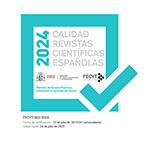Motherhood, reproduction and up-bringing stories in the post-television era
Abstract
The objective of this study is to analyze current television fictions starred by mothers and focused on the process of reproduction and upbringing, in order to observe how the biological processes linked to motherhood and rearing are represented. After centuries in which the search for pregnancy, infertility, abortions, gestation, perinatal losses, delivery, breastfeeding and postpartum have been silenced in cultural works, or treated in a symbolic way without including the feminine subjectivity, we want to observe if the current moment of gender claims, as well as the greater production of fiction and the ease of accessing specific contents, has generated a greater plurality of discourses. From the content analysis of five series premiered in recent years we observe production features, which stages of reproduction are most commonly shown, the connotations they obtain, the problems they show and from which perspective issues such as conciliation, father’s role, family relationships and changes in the body are displayed. The study concludes that the digitization and distribution of streaming content has led to an increase in works that focus on the reproduction stage, that there is a relationship between the increase of women in creative teams and the greater exploration of these issues and that the discourse proposed in these series distances itself from the traditional representation of motherhood and includes a detailed description of vital stages that had no place in television fiction before.
Downloads
Article download
License
In order to support the global exchange of knowledge, the journal Investigaciones Feministas is allowing unrestricted access to its content as from its publication in this electronic edition, and as such it is an open-access journal. The originals published in this journal are the property of the Complutense University of Madrid and any reproduction thereof in full or in part must cite the source. All content is distributed under a Creative Commons Attribution 4.0 use and distribution licence (CC BY 4.0). This circumstance must be expressly stated in these terms where necessary. You can view the summary and the complete legal text of the licence.











